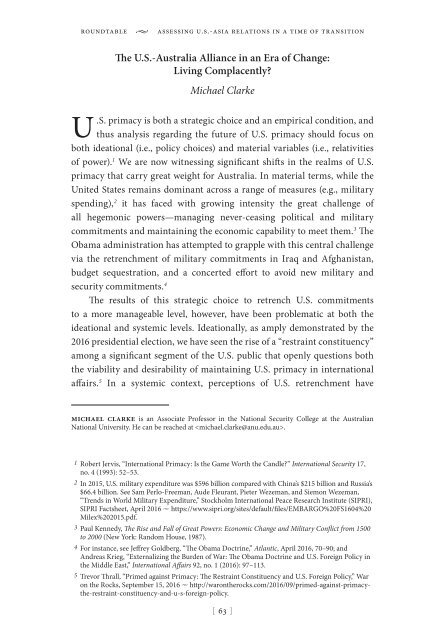2jBVKVf
2jBVKVf
2jBVKVf
You also want an ePaper? Increase the reach of your titles
YUMPU automatically turns print PDFs into web optimized ePapers that Google loves.
oundtable • assessing u.s.-asia relations in a time of transition<br />
The U.S.-Australia Alliance in an Era of Change:<br />
Living Complacently?<br />
Michael Clarke<br />
U<br />
.S. primacy is both a strategic choice and an empirical condition, and<br />
thus analysis regarding the future of U.S. primacy should focus on<br />
both ideational (i.e., policy choices) and material variables (i.e., relativities<br />
of power). 1 We are now witnessing significant shifts in the realms of U.S.<br />
primacy that carry great weight for Australia. In material terms, while the<br />
United States remains dominant across a range of measures (e.g., military<br />
spending), 2 it has faced with growing intensity the great challenge of<br />
all hegemonic powers—managing never-ceasing political and military<br />
commitments and maintaining the economic capability to meet them. 3 The<br />
Obama administration has attempted to grapple with this central challenge<br />
via the retrenchment of military commitments in Iraq and Afghanistan,<br />
budget sequestration, and a concerted effort to avoid new military and<br />
security commitments. 4<br />
The results of this strategic choice to retrench U.S. commitments<br />
to a more manageable level, however, have been problematic at both the<br />
ideational and systemic levels. Ideationally, as amply demonstrated by the<br />
2016 presidential election, we have seen the rise of a “restraint constituency”<br />
among a significant segment of the U.S. public that openly questions both<br />
the viability and desirability of maintaining U.S. primacy in international<br />
affairs. 5 In a systemic context, perceptions of U.S. retrenchment have<br />
michael clarke is an Associate Professor in the National Security College at the Australian<br />
National University. He can be reached at .<br />
1 Robert Jervis, “International Primacy: Is the Game Worth the Candle?” International Security 17,<br />
no. 4 (1993): 52–53.<br />
2 In 2015, U.S. military expenditure was $596 billion compared with China’s $215 billion and Russia’s<br />
$66.4 billion. See Sam Perlo-Freeman, Aude Fleurant, Pieter Wezeman, and Siemon Wezeman,<br />
“Trends in World Military Expenditure,” Stockholm International Peace Research Institute (SIPRI),<br />
SIPRI Factsheet, April 2016 u https://www.sipri.org/sites/default/files/EMBARGO%20FS1604%20<br />
Milex%202015.pdf.<br />
3 Paul Kennedy, The Rise and Fall of Great Powers: Economic Change and Military Conflict from 1500<br />
to 2000 (New York: Random House, 1987).<br />
4 For instance, see Jeffrey Goldberg, “The Obama Doctrine,” Atlantic, April 2016, 70–90; and<br />
Andreas Krieg, “Externalizing the Burden of War: The Obama Doctrine and U.S. Foreign Policy in<br />
the Middle East,” International Affairs 92, no. 1 (2016): 97–113.<br />
5 Trevor Thrall, “Primed against Primacy: The Restraint Constituency and U.S. Foreign Policy,” War<br />
on the Rocks, September 15, 2016 u http://warontherocks.com/2016/09/primed-against-primacythe-restraint-constituency-and-u-s-foreign-policy.<br />
[ 63 ]


